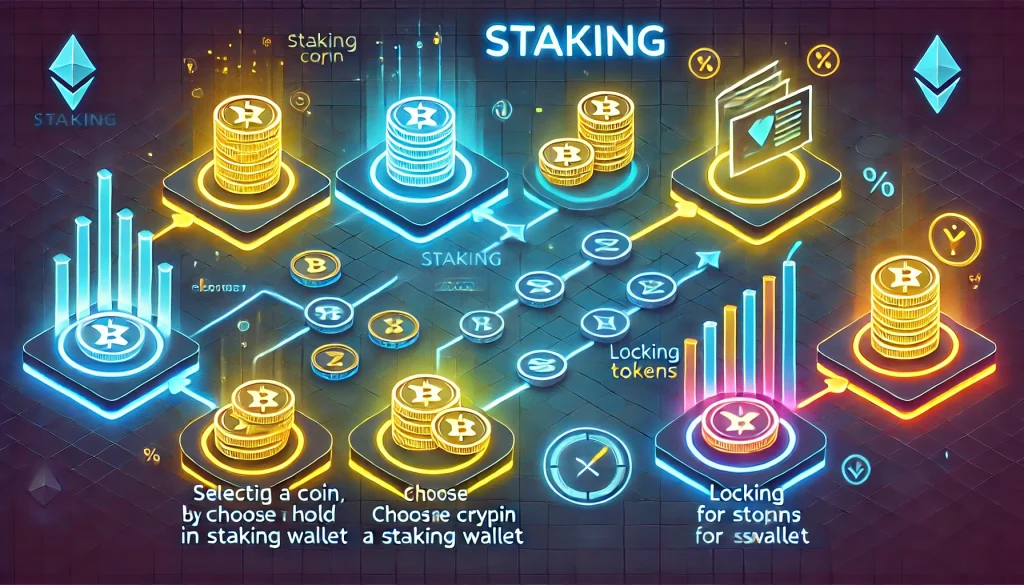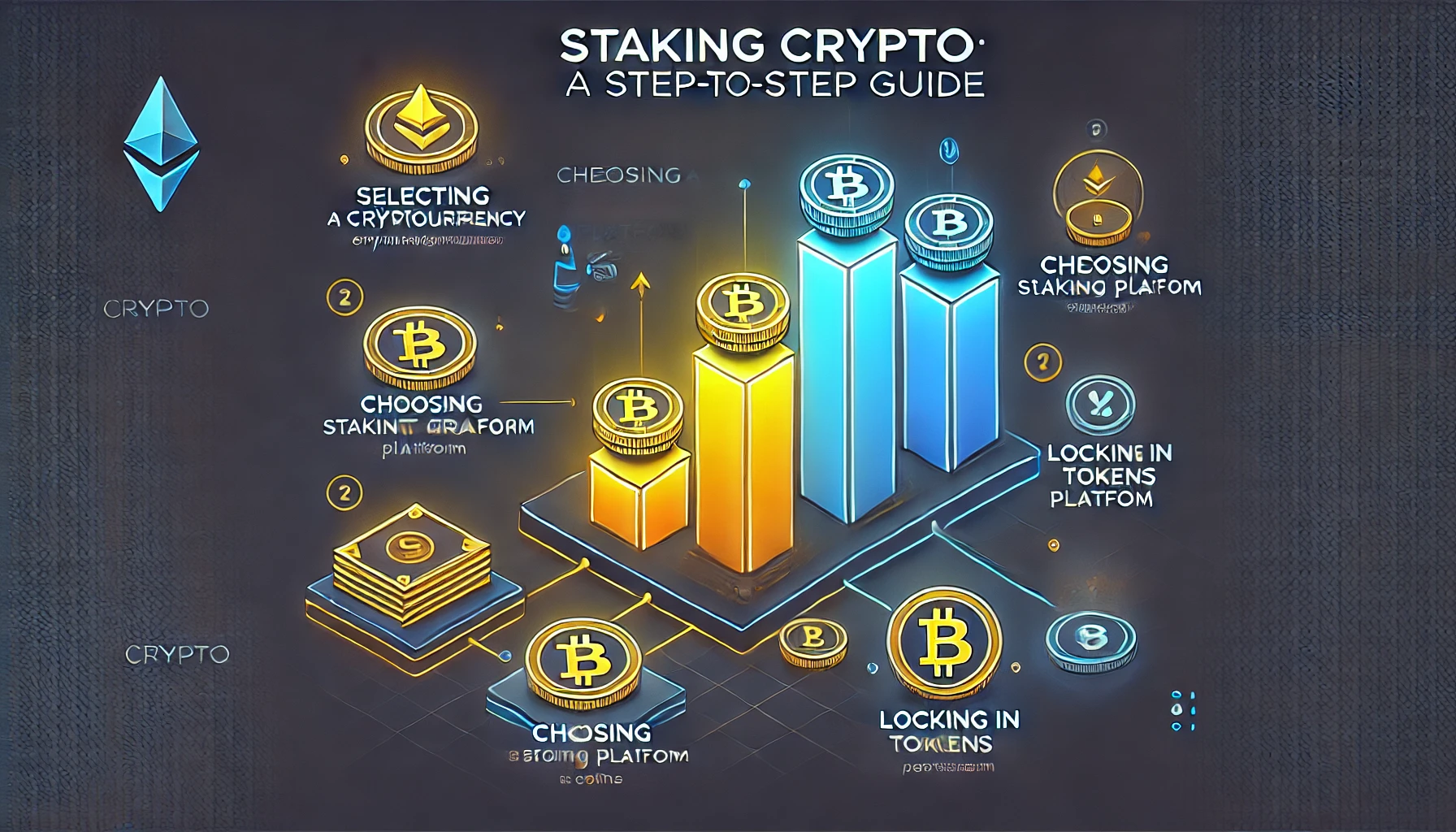Staking cryptocurrency has gained massive popularity as a way to earn passive income while contributing to the blockchain network’s security. But what exactly is staking crypto, and how can you benefit from it? In this step-by-step guide, we’ll break down everything you need to know about staking, its benefits, and the tools required to get started. Whether you’re a beginner or an experienced investor, staking is an excellent strategy to grow your crypto assets over time.
Understanding Staking Crypto: A Beginner’s Guide

Staking crypto involves locking up your cryptocurrency holdings in a blockchain network to help validate transactions and improve the network’s overall security. In return, participants are rewarded with additional coins, making staking a valuable method for earning passive income. With platforms like Coinbase Staking and others offering accessible options, more investors are turning to staking as a long-term strategy.
Not only does staking offer the potential for higher returns compared to simply holding your coins, but it also plays a critical role in maintaining decentralized networks like Ethereum and Cardano. As more users adopt staking, they strengthen these networks, ensuring faster transaction times and improved scalability.
If you’re looking to make your idle crypto work for you, here’s how to get started with staking crypto!
How to Stake Crypto: A Step-by-Step Process
Before you dive into staking, ensure you have the necessary tools and prerequisites. Below is a table listing the basic materials you’ll need:
| Materials | Description |
|---|---|
| Cryptocurrency Wallet | A secure wallet compatible with staking coins. |
| Supported Crypto Coins | Coins that support staking, such as ETH, ADA, or SOL. |
| Staking Platform | Platform offering staking services (e.g., Coinbase Staking). |
| Internet Connection | A reliable connection to access staking services online. |
| Minimum Coin Requirement | Some coins require a minimum amount to start staking. |
Important Tips and Warnings for Staking Crypto

Staking cryptocurrency is an attractive way to earn passive income, but it comes with its own set of risks and considerations. Below are some crucial tips and warnings to keep in mind before you start staking your crypto assets.
Understand the Risks of Lock-Up Periods
When you stake your crypto, it often becomes locked in the staking protocol for a set period. This means you cannot sell or transfer your staked assets until the lock-up period ends. Depending on the asset, this lock-up period can range from a few days to several months. For example, staking Ethereum 2.0 requires locking up your ETH until the Ethereum network fully transitions to the new proof-of-stake model, which could take several years. Make sure you’re comfortable with this illiquidity, as it can be risky in volatile markets.
Be Aware of Slashing Risks
Some staking networks, like those based on the proof-of-stake (PoS) model, have penalties called “slashing.” If a validator (the person or entity staking) behaves dishonestly or their node goes offline, a portion of their staked assets may be forfeited as a penalty. This risk highlights the importance of choosing reliable validators or platforms. Always research validators’ reputations and uptime before staking your assets with them.
Security Should Be a Priority
Staking involves moving your crypto to a platform or wallet that supports staking. Security should be a primary concern, as the platform you choose will be holding your assets for an extended period. Consider using hardware wallets like Ledger or Trezor for the highest level of security, and ensure that any platform you choose has a strong track record of security and transparency. Multi-factor authentication (MFA) should also be enabled to further protect your assets.
Diversify Your Staking Portfolio
Just as with traditional investing, it’s a good idea to diversify your staking assets. Different networks offer varying reward rates, and some might be more reliable than others. For instance, staking Cardano (ADA) might provide consistent returns, while Solana (SOL) could offer higher rewards but with increased volatility. By staking multiple assets, you can reduce risk and optimize your returns.
Stay Informed About Network Changes
Cryptocurrency networks regularly undergo updates that can impact staking rewards, lock-up periods, and other staking mechanics. For example, major network upgrades like Ethereum’s transition to Ethereum 2.0 significantly affect how staking works. Stay informed by following official channels, blogs, or forums related to the crypto assets you’re staking.
Step 1: Choose a Staking Platform
Selecting the right staking platform is crucial for maximizing rewards and ensuring security. You can stake directly from a crypto wallet that supports staking, such as Ledger or MetaMask, or use third-party platforms like Coinbase Staking or Stakingly. When choosing a platform, consider factors like the user interface, supported coins, and staking fees.
For example, Coinbase Earn is a beginner-friendly platform with a straightforward interface, making it easy to stake a wide range of cryptocurrencies. Ensure the platform you choose supports the asset you intend to stake and offers competitive reward rates.
Step 2: Select a Staking Crypto Asset
Not every cryptocurrency supports staking. Some of the most popular assets for staking include Ethereum 2.0 (ETH), Cardano (ADA), and Solana (SOL). Each crypto has different staking mechanics, such as varying reward rates and lock-up periods. For example, Ethereum 2.0 can yield rewards between 4% and 7% annually, while Solana can offer up to 10%, though these rates fluctuate.
Before selecting an asset, ensure you understand the network’s requirements and current reward rates. You should also consider factors such as the minimum staking amount and the network’s lock-up period. For example, staking Cardano (ADA) typically has no mandatory lock-up period, allowing more flexibility.
Step 3: Transfer Your Coins to a Staking Wallet
After choosing your platform and crypto asset, the next step is to transfer your coins into a staking-compatible wallet. Many platforms, such as Coinbase Staking, allow staking directly from their wallets. However, if you’re using a third-party service like Stakingly, you’ll need to link your wallet to the platform.
Be sure to use a secure wallet that supports staking features. Ledger, Trust Wallet, and MetaMask are widely used for staking due to their high-security features. After transferring your coins, verify that they are securely stored and ready for staking.
Step 4: Start Staking
Once your assets are in the staking wallet, you can begin the staking process. This typically involves selecting the amount of crypto you wish to stake and confirming the lock-up period, if applicable. Some platforms, like Coinbase Staking, offer simple one-click options for staking popular assets like Ethereum 2.0, with rewards automatically deposited into your account periodically.
Certain coins have minimum staking periods, while others may offer more flexibility. For instance, Solana allows you to unstake after a few days, whereas Ethereum 2.0 requires you to lock up your assets until the network fully transitions to proof-of-stake.
Step 5: Monitor Your Staking Rewards
Once staking is active, you can sit back and monitor your rewards. Most platforms offer transparent tools to track your estimated rewards, which are typically paid out in the same cryptocurrency that you staked. For example, staking platforms like Stakingly provide detailed insights into how your staked assets are performing, helping you manage your staking portfolio effectively.
Rewards can be reinvested to maximize your returns or sold for other crypto assets. Keep an eye on fluctuating network conditions, as these can impact reward rates and staking profitability.
Tips and Warnings

Tips for Success:
- Diversify your staking assets to minimize risk. Instead of staking only one crypto asset, consider spreading your holdings across several best staking crypto options like ADA, ETH, and SOL.
- Keep an eye on network updates. Changes in blockchain protocol, reward rates, or minimum staking requirements can impact your returns.
- Use platforms with low fees. Some platforms may charge high staking fees, which will eat into your rewards. Look for those with competitive rates, such as Coinbase Earn.
Warnings:
- Be cautious with lock-up periods. Some staking platforms lock your coins for a set period, preventing you from selling or trading during that time. Make sure you’re comfortable with the lock-up duration.
- Watch out for scams. Only use reputable platforms like Coinbase Staking to avoid phishing attacks or fraudulent staking schemes.
- Understand the risks. Staking isn’t without risks—network bugs, market volatility, or hacks could impact your staked coins.
Conclusion
Staking crypto is an excellent way to earn passive income while supporting the blockchain network. By following this step-by-step guide, you can start staking your crypto assets, from choosing the right platform to monitoring your rewards. Platforms like Coinbase Staking and Stakingly have made the process easier than ever, and with proper research and planning, you can maximize your staking returns.
So why wait? Start staking today and watch your crypto holdings grow!
FAQ
What is staking crypto, and how does it work?
Staking crypto involves locking your cryptocurrency in a blockchain network to validate transactions and secure the network. In return, you earn rewards in the form of additional coins. Platforms like Coinbase Staking offer easy access to staking services, making it simpler for beginners to get involved.
Which is the best staking crypto for beginners?
Some of the best staking crypto options for beginners include Ethereum 2.0 (ETH), Cardano (ADA), and Solana (SOL). These coins offer competitive staking rewards and are supported on major platforms like Coinbase Earn. Always research the coin’s staking requirements and reward rates before making a decision.
What is the difference between Coinbase Earn and Coinbase Staking?
Coinbase Earn is an educational initiative that allows users to earn crypto by learning about different assets. Coinbase Staking, on the other hand, is a service that lets users earn staking rewards by locking their coins in the network. Both are great tools, but Coinbase Staking is designed for earning long-term passive income from your crypto holdings.
Resources
- britannica.com. What Is Crypto Staking?
- bitcoinmarketjournal.com. How to Start Staking Cryptocurrency
- bitpanda.com. How to Start Staking Crypto
- aibc.world. Staking Crypto 101 Guide
- chainalysis.com. Crypto Staking: Everything You Need to Know

